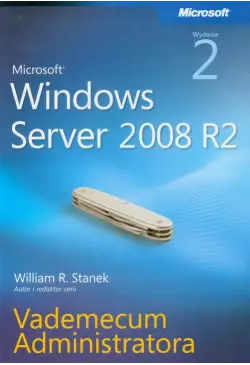
- Za darmo
ebook Discrete mathematics for computer science students
Odkryj fascynujący świat dyskretnej matematyki dla studentów informatyki - idealne wprowadzenie do kluczowych pojęć i narzędzi, które stanowią fundament nowoczesnego podejścia do informatyki. Autorka Renata Kawa z Uniwersytetu Jana Długosza w Częstochowie przygotowała ten kompleksowy przewodnik na rok 2024, aby pomóc Ci zgłębić tajniki dyskretnej matematyki.
Czy jesteś gotowy rozwinąć swoje umiejętności rozwiązywania problemów i tworzenia skutecznych algorytmów? Ten ebook to Twój klucz do sukcesu w dziedzinie informatyki!
Dlaczego warto wybrać ten ebook:
- Fundamentalne pojęcia dyskretnej matematyki: Dowiedz się, jak logicznie, zbiory i teoria liczb tworzą podstawę dla wielu dziedzin informatyki.
- Praktyczne zastosowania: Poznaj praktyczne aspekty kombinatoryki, teorii grafów i ich znaczenie w algorytmach, kryptografii i teorii obliczeń.
- Zadania do rozwiązania: Rozwijaj swoje umiejętności poprzez zestawy zadań wraz z odpowiedziami, które pomogą Ci utrwalić zdobytą wiedzę.
- Przykładowe egzaminy: Przygotuj się do nadchodzących wyzwań akademickich dzięki zestawowi pytań egzaminacyjnych, które sprawdzą Twoją wiedzę.
Ten ebook to idealne źródło wiedzy dla:
- Studentów informatyki na pierwszym roku studiów.
- Osób zainteresowanych matematyką i informatyką, które chcą poszerzyć swoją wiedzę.
- Nauczycieli poszukujących materiałów dydaktycznych do nauczania dyskretnej matematyki.
Pobierz ten ebook teraz i:
- Zwiększ swoje szanse na sukces w informatyce.
- Odkryj, jak dyskretna matematyka kształtuje nowoczesne technologie.
- Ciesz się wygodnym formatem PDF do czytania na dowolnym urządzeniu.
Nie przegap tej szansy! Zamów teraz swój ebook "Discrete Mathematics for Computer Science Students" i rozpocznij przygodę z dyskretną matematyką już dziś.
Spis treści ebooka Discrete mathematics for computer science students
ContentsNotations 4
Preface 5
1. Elements of Logic 6
1.1. Basics of Propositional Calculus . . . . . . . . . . . . . . . . . . . . . . . . 6
1.2. Basics of Quantifier Calculus . . . . . . . . . . . . . . . . . . . . . . . . . 10
1.3. Elements of Set Theory . . . . . . . . . . . . . . . . . . . . . . . . . . . . 13
1.4. Elements of Relation Theory . . . . . . . . . . . . . . . . . . . . . . . . . 17
1.5. Notation for Sums and Products . . . . . . . . . . . . . . . . . . . . . . . 20
1.6. Mathematical Induction . . . . . . . . . . . . . . . . . . . . . . . . . . . . 22
1.7. Integer-Valued Functions . . . . . . . . . . . . . . . . . . . . . . . . . . . . 24
1.8. Exercises . . . . . . . . . . . . . . . . . . . . . . . . . . . . . . . . . . . . 25
1.9. Answers . . . . . . . . . . . . . . . . . . . . . . . . . . . . . . . . . . . . . 30
2. Elements of Number Theory 37
2.1. Divisibility of Numbers . . . . . . . . . . . . . . . . . . . . . . . . . . . . . 37
2.2. Prime and Composite Numbers . . . . . . . . . . . . . . . . . . . . . . . . 39
2.3. Greatest Common Divisor and Least Common Multiple . . . . . . . . . . 41
2.4. Euclidean Algorithm . . . . . . . . . . . . . . . . . . . . . . . . . . . . . . 43
2.5. Relatively Prime Numbers . . . . . . . . . . . . . . . . . . . . . . . . . . . 46
2.6. Exercises . . . . . . . . . . . . . . . . . . . . . . . . . . . . . . . . . . . . 47
2.7. Answers . . . . . . . . . . . . . . . . . . . . . . . . . . . . . . . . . . . . . 49
3. Elements of Combinatorics 53
3.1. Factorial and Binomial Coefficient . . . . . . . . . . . . . . . . . . . . . . 53
3.2. Variations, Permutations, and Combinations . . . . . . . . . . . . . . . . . 56
3.3. The Multiplication and Addition Principles . . . . . . . . . . . . . . . . . 59
3.4. Various Problems . . . . . . . . . . . . . . . . . . . . . . . . . . . . . . . . 61
3.5. Inclusion-Exclusion Principle and Dirichlet’s Box Principle . . . . . . . . . 64
3.6. Exercises . . . . . . . . . . . . . . . . . . . . . . . . . . . . . . . . . . . . 66
3.7. Answers . . . . . . . . . . . . . . . . . . . . . . . . . . . . . . . . . . . . . 78
4. Sample Exam Questions 88
The bibliography 92
3
Szczegóły ebooka Discrete mathematics for computer science students
- Wydawca:
- Uniwersytet Jana Długosza w Częstochowie
- Rok wydania:
- 2024
- Typ publikacji:
- Ebook
- Język:
- angielski
- Format:
- Liczba stron:
- 92
- Miejsce wydania:
- Częstochowa
- ISBN dla wersji papierowej:
- 9788367984218
Recenzje ebooka Discrete mathematics for computer science students
-
Reviews (0)

Na jakich urządzeniach mogę czytać ebooki?
- Za darmo
















@CUSTOMER_NAME@
@COMMENT_TITLE@
@COMMENT_COMMENT@